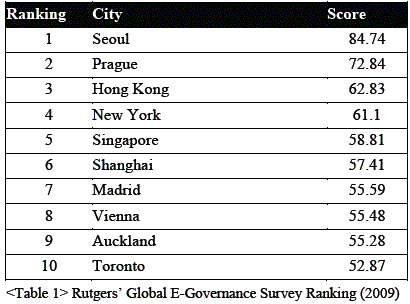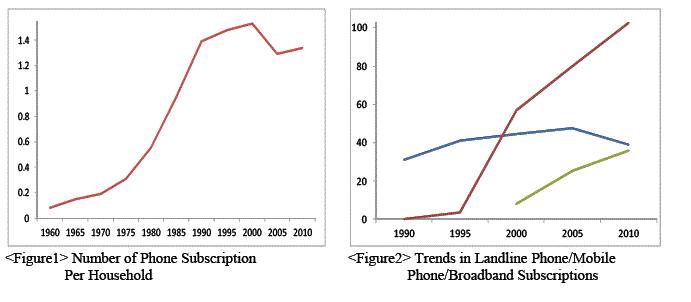حكومة سيول الإلكترونية لأجل مدينة ذكية
ISSUES
Since 1985, the supply rate of personal computers has been increased 17.6 times from 5% in 1985 to 86% in 2009. Until the mid 1960s one every ten households had a phone subscription, but increased to 0.54 person per household in 1997, then to 1.56 in 1997, and finally by 2007 1.34 persons per household had phone connection. This can be attributed to the increasing mobile phone use since the 1990s. It is shown in the fact that the number of phone subscriptions was 0.2 per every 100 in 1990 before it became 105.5 as of 2011. In regards to the broadband internet subscription, the number of subscription moved from 8.2 in 2000 to be radically increased to 35.9 as of 2011, multiplying 4.4 times.
As a means to achieve governmental efficiency and innovation, transparency and accountability, accessibility of government and civic participation, Seoul's e-government policy tried to encourage the active engagement of citizens in ICT, while building a cooperative relationship between the Seoul Metropolitan Government and citizens.
SOLUTIONS
Solution 1: Government-driven promotion and Seoul’s compliance
Since 1978 when the first Basic Plan for Administrative Computerization was laid out, introducing ICT technology to public administration became a main agenda. Computerization, a preceding step to informatization, promotes use of computers in managing large data. During this era computing practices was of the punched card computing level, so the range of computerization was limited to simple tasks and compiling or processing databases. The focus was on developing inter-governmental network and thereby increasing work efficiency. The major policies and projects undertaken by the central government since 1978 to promote e-government included the first and second Administrative Task Computerization Plans, Rule of Administrative Task Computerization, National Basic Computing Network Project and Administrative Computing Network Project Plan. Despite such endeavors, however, very few investors were willing to get involved because of the low level of technology and uncertainties. Seeing the benefits of computerization projects and e-government, SMG was not discouraged to continue its investment and collaboration with the central government, allocating financial and institutional supports on e-government projects from the early stage. For example, Information System Planning Bureau provided a critical assistance in gathering the citywide compliance.
Solution 2: Coordination and Directing via the SMG Information System Planning Bureau
The informatization project incrementally expanded in scope and scale since the city’s early efforts in 1971 to computerize main administrative tasks such as budgeting, accounting and personnel affairs. In compliance with such national plans as Basic Plan for Administrative Computerization and Act on Promotion & Usage of Computer Network in 1987, SMG took an initiative for e-government transformation through its own plans. Incomplete implementation in the early days of digitalization projects, contrary to the expectations, created extra workload at the city hall. While sharing of administrative information was partially made possible, data management by individual agencies was still scattered. As a response to the calling for a full integration of e-government services across different administrative divisions, Information System Planning Bureau (ISPB) was launched in pursuit of administrative efficiency. ISPB serves as the main implementation body that directs comprehensive planning and coordination of e-government projects. As of now, it consists of 4 directors, 23 teams and 4 divisions housing 989 staffs in total.
Solution 3: Enhanced Paradigm: From efficiency to transparency and citizen participation
Following the early efficiency-driven approach towards e-government, Seoul has moved its focus since the 2000s to digitalization and disclosure of administrative information to promote the citizens’ participation and transparency in the administrative process. Measures taken to foster administrative efficiency include “Seoul e-Tax System”, “120 Dasan Call Center”. Innovative measures are in operation for the transparency in the city administration, for instance “Seoul Child Care portal” and “Oasis,” an online policy suggestion system.
ACHIEVEMENTS
A research study conducted by Rutgers University has identified Seoul as the top city in the field of e-government. Seoul was ranked number 1 in terms of usability, service, and citizen participation, making Seoul’s municipal e-governance one of the best among cities in OECD countries.

Disclosure of Public Information
“Open Government 2.0” is built to push forward civil administrative services based on participation from the citizens, disclosing city documents and extensive public database.
The system is expected to leverage the mutual understanding between the citizens and the SGM staffs along with the prospective growth of the industry which would benefit from public data, establishing Seoul as one of the most advanced smart cities in the world.

Another faucet of e-government’s achievements is demonstrated by online government information access, document issuance, tax administration, and welfare service.
Improvement in ICT Work Environments and Realization of Smart City
Upgrades are ongoing in ICT facilities to ensure sustainability in smart governance. SMG is working on setting up the groundwork for smart administrative service to meet a variety of administrative demands through its enhanced administrative support and integrated management. For example, the management of U-work Center boasts its world-class ICT facilities to improve employee’s productivity and help tackle low fertility rate.
SUCCESS FACTORS
There are factors both within and outside the SMG behind the success of e-government in Seoul. Some key external factors in Seoul’s rise as an e-government powerhouse include the central government’s ambitious promotion and supply-driven strategies in the ‘80s. Also instrumental was the cooperative implementation between the central government and SMG. As for the internal factors, institutionalization of controlling body played a vital part. Collaborating with the staff on ideas and resolutions, Mayor’s strong commitment and keen interest in the open and smart administration was another crucial factor.
